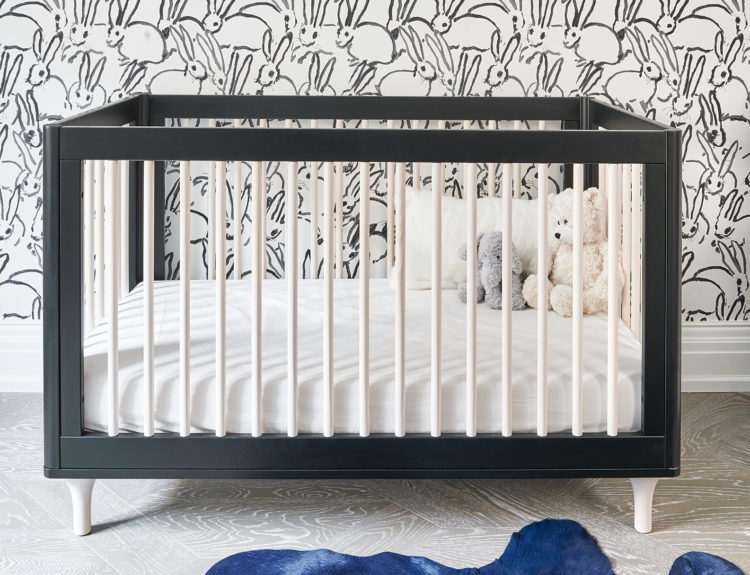This baby’s nursery is going to be done to the nines, and she’s going to give zero f*cks. My first daughter lived in a solarium in Vancouver when she was born and she was fine. It’s all for the parents!
Ali Budd, Ali Budd Interiors
Creating a nursery is an exciting but sometimes overwhelming part of welcoming a new baby. With images of stunning nurseries plastered all over the internet, there’s tons of pressure to make ours look picture-perfect. But it’s easy, especially as first-time parents, to fall into some common design pitfalls. That’s why we sat down with the incredibly talented Ali Budd, principal at Ali Budd Interiors, and badass mom of 2 (+ 1 on the way) to capture her hard-earned wisdom on what to consider—and avoid—when designing a space for your little one.
What To Do (Bites)
-
Don’t design for a baby, design for you
Let’s be honest, nurseries are for the parents. You’re the one who will be awake in there the most. What kind of space do you want to walk into? What type of environment makes you feel good? Between toys and books, baby will be plenty stimulated – the walls don’t have to do that job. The infant stage is so fun but finite, so stay away from too much ABC, anything too multi-colored, or too ‘baby’. If you want to infuse some sweet elements, the best places to do so are on crib sheets or mobiles, and through books and stuffed animals. These are all easily changed. You’ll replace baby bear wallpaper in no time, so go for decals so you can peel them off when you’re over them, or choose that bear wallpaper in a black and white palate to make it feel more edgy, and last. When looking at options, ask yourself: “is this too babyish? Will I have to change it when they turn 5?” If “yes” to either, think again.
-
Put your money in the chair
You’re going to be spending hours upon hours feeding, rocking, and reading to your little one in the nursery chair. These are the precious moments you’ll remember, so invest in a great chair where it’ll all happen, so you can be comfortable. Splurge for the one that rocks, reclines, has gel cushioning – the whole shebang. West Coast Kids has a great selection. For the chair, or any major piece of furniture, think about what will grow with baby through to their toddler and kid years, and go for well made, chic, and neutral.
-
Don’t overcrowd a nursery
It’s easy to get carried away with all the cute kids’ stuff, but avoid creating a baby obstacle course. Before you know it, they’ll be scooting, pulling up, running in circles around their room. You truly only need a crib, chair, dresser, and small bookcase (make sure to secure anything that can topple over to the wall). Forget change tables – they’re a waste of space and short-lived. Instead throw a changing pad on a dresser that you love. And don’t feel like you need to display everything at once. Store excess books in the closet, and when you’re tired of Goodnight Moon, rotate it out.
Joey wants a poster from some tween show on her wall. It’s her room, her safe spot. She’s got a Barbie house and camper in there. I want it to look like a magazine but that’s not how she wants to live.
I’m going to have to get over it.

Tips
-
Skip the rug, go with a play mat in the nursery. When your kid gets into a bed, you’ll probably need to reorient the room and want a bigger rug. Nowadays you can get really stylish play mats from Play with Pieces or Personalized Playmats. They are good for barf, poo, and the tumbles that come with learning to walk. And you can easily relocate them to a playroom or basement down the road.
-
Kids rooms can (and should) stand out. Some people think that a kid’s room should be consistent with the overall feeling of the house. But kid’s rooms are spaces to go for it and have fun, so do whatever you want in there, regardless of what’s going on in the rest of the home.
-
Give bigger kids a voice in what their rooms look like (within reason). One way to let them assert some control— without ending up with Batman everything— is to show them three choices that you’ve pre-approved and let them make the ultimate decision. They’ll feel ownership and you’ll be okay with whatever they choose.
“When I did my maternity shoot, I had my family, my nanny and my entire staff participate. That’s my whole team. I don’t keep my two worlds separate.”

MY CHOICES. MY WISDOM.
As a veteran mom of two kids, you’re pregnant and going back to the beginning. What will you do differently?
“I think your first and your third are really different. You have no idea what to do with your first. Your life changes in a blink. You’re leaving the hospital thinking: does anyone just realize what happened to me? With my third, I know that everything is finite. The hard stages come and go. I look at my children, who are 7 and 5, and they’re not babies anymore. It goes fast. I think when it’s tough, I’ll remember to take a breath and keep things in perspective.”
You’re newly remarried, how did you keep it together as a single mom running your own business?
“A lot of people try to hide their help as though it belittles what they’re doing, but I physically couldn’t do it without a nanny. I needed full-time help. So I sacrificed other things to make it work – I wasn’t going out as much as I wanted to or buying certain things. I’m just re-doing my kitchen now, though I wanted to do it 5 years ago. Being a single mom lit a fire under my ass to really provide for my family.”
How do you balance these two competing systems of work and kids?
“My parents worked together and I grew up in their office. It was a huge blend. It meant I could be around them more and know them better. I want that for my children, to see me in a professional capacity. That’s why I’m building a nursery in our office. I want them to see that Mommy’s doing things, helping people, working hard. When it’s appropriate I tell my kids the things that stress me out that day – my parents did that with me, and it helped me feel close to them. I don’t keep those worlds separate. 9am-5pm doesn’t work anymore so the dynamic of jobs and cultures at work need to change to better accommodate a blend.”
How do you manage mom guilt?
“There comes a point where you have to let certain things go – or else you’ll feel like a failure constantly. I see a therapist once every two weeks to keep my head straight. I’m very open about it and it’s been important to keep me grounded. I’ve learned I have to be kinder to myself and forgive myself for the mom stuff and the work stuff. I can’t be everything to everyone at every minute.”
What’s the big piece of wisdom that you’ve learned that you would love to share with others?
“Stop comparing yourself to everyone else and what they’re doing. You know in your heart what’s right for you and your family. Forget other peoples’ opinions, thoughts, advice. If you sit and think, you know what’s right. And don’t forget the joy in it either. A lot of moms complain about how hard it is. It is. I get it, but don’t lose the joy. The joy will keep you going.”
When your kids become adults, what is the one thing you hope they will say about you?
“I hope my daughters will grow up to be independent, whatever that means for them, and create lives for themselves that aren’t reliant on anyone rescuing them. I hope my son understands that it’s not mutually exclusive to be successful and an amazing mother, wife or partner, that women don’t have to pick. I hope they’re good, decent, loving people who understand that life throws curveballs at you, and that’s it’s up to you to choose what to do with what happens to you.”



